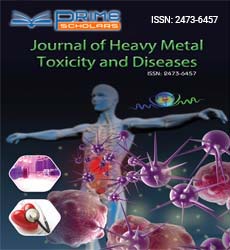Perspective - (2023) Volume 8, Issue 6
Innovations Transforming Heavy Metal Detection and Remediation
Robert Joseph*
Department of Chemistry, University of Belgrade, Serbia
*Correspondence:
Robert Joseph,
Department of Chemistry, University of Belgrade,
Serbia,
Email:
Received: 29-Nov-2023, Manuscript No. ipjhmct-24-18971;
Editor assigned: 01-Dec-2023, Pre QC No. ipjhmct-24-18971 (PQ);
Reviewed: 15-Dec-2023, QC No. ipjhmct-24-18971;
Revised: 20-Dec-2023, Manuscript No. ipjhmct-24-18971 (R);
Published:
27-Dec-2023, DOI: 10.21767/2473-6457.23.6.53
Introduction
Heavy metal contamination is a persistent environmental
challenge with far-reaching consequences for ecosystems and
human health. In response to this pressing issue, researchers
and technologists are leveraging cutting-edge innovations
to develop advanced methods for both the detection and
remediation of heavy metals. This article explores the latest
emerging technologies, showcasing how these breakthroughs
are reshaping our approach to tackling heavy metal pollution.
Description
Advanced sensor technologies traditional methods of heavy
metal detection often involve time-consuming laboratory
analyses. However, advancements in sensor technologies are
revolutionizing this process. Miniaturized and portable sensors,
utilizing techniques such as voltammetry and impedance
spectroscopy, allow for rapid on-site detection of heavy metals in
soil, water, and air. These sensors provide real-time data, enabling
quicker responses to contamination incidents. Remote sensing
technologies, including satellite and drone-based imaging, are
enhancing our ability to detect heavy metal contamination over
large areas. Hyperspectral imaging can identify subtle changes in
the electromagnetic spectrum, pinpointing areas with elevated
metal concentrations. This approach aids in early detection
and facilitates targeted remediation efforts. The integration of
AI and ML algorithms with heavy metal detection systems has
significantly improved the accuracy and efficiency of analyses.
These technologies can process vast datasets, recognize
patterns, and predict potential contamination hotspots. AIenhanced
detection methods are crucial for managing complex
environmental systems and identifying trends that may be
challenging for traditional approaches to discern.
Harnessing the power of living organisms, biosensors offer a
biologically-driven approach to heavy metal detection. Engineered
microorganisms, enzymes, or DNA sequences can be tailored
to specifically react to certain metals, producing measurable
signals. This eco-friendly method is not only sensitive but also
cost-effective, providing a sustainable alternative for continuous
monitoring. Electrochemical techniques, such as electrokinetic and
electrodialytic methods, have gained prominence in remediating
heavy metal-contaminated soils. By applying electric fields, these
methods mobilize and transport metals, facilitating their removal
or immobilization. Electrochemical approaches are particularly
effective in addressing localized contamination and reducing the
environmental impact of traditional excavation. Nanotechnology
plays a pivotal role in remediation efforts. Nanoparticles,
such as zero-valent iron and titanium dioxide, exhibit unique
properties that can facilitate the removal or transformation of
heavy metals. Engineered nanomaterials provide a targeted
and efficient approach, minimizing the ecological footprint
associated with conventional remediation techniques. Plants
continue to be valuable allies in the fight against heavy metal
contamination. Researchers are now focusing on enhancing the
natural abilities of certain plants to accumulate and tolerate
heavy metals. Genetic engineering and molecular breeding are
being explored to develop hyperaccumulating plants capable of
thriving in contaminated environments, providing a sustainable
and aesthetically pleasing remediation solution. Harnessing
the metabolic capabilities of microorganisms offers a biological
alternative for remediating heavy metal pollution. Microbes can
either accumulate metals or facilitate their transformation into
less toxic forms.
Conclusion
The landscape of heavy metal detection and remediation is
undergoing a profound transformation. The synergy of innovative
sensor technologies, AI-driven analyses, and sustainable
remediation methods holds immense promise for mitigating the
impact of heavy metal pollution on our environment and wellbeing.
As these technologies continue to evolve, they pave the
way for a future where the threats of heavy metal contamination
are effectively addressed through precision, efficiency, and
environmental stewardship.
Citation: Joseph R (2023) Innovations Transforming Heavy Metal Detection and Remediation. J Heavy Met Toxicity Dis. 08:53.
Copyright: © 2023 Joseph R. This is an open-access article distributed under the terms of the Creative Commons Attribution License, which permits unrestricted use, distribution, and reproduction in any medium, provided the original author and source are credited.

